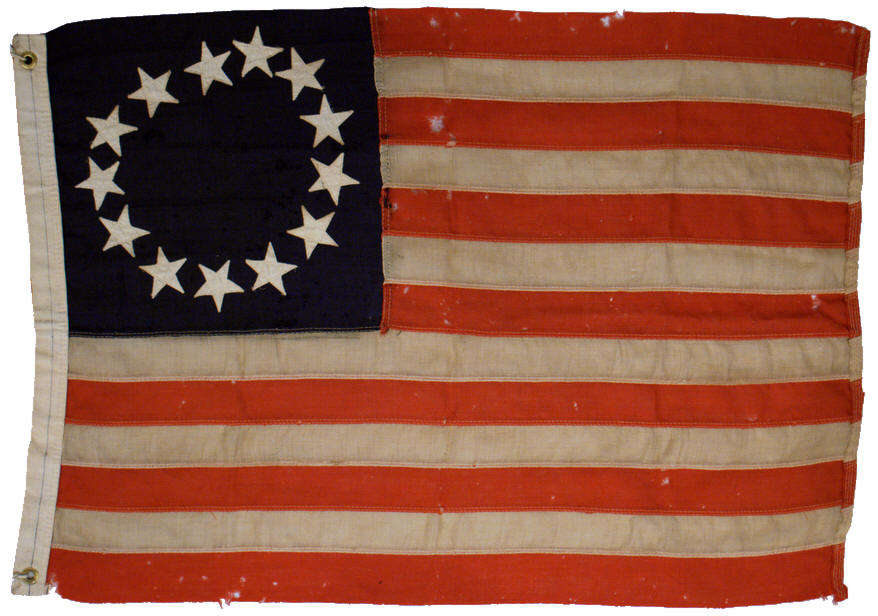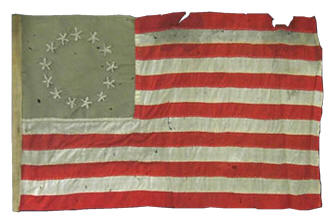
Antique flags in the
Betsy Ross pattern are not known prior to the period of
the Civil War, and only a handful of 19th century
examples exist. The pattern became increasingly
popular in the first quarter of the 20th century,
although less than one percent of antique 13 star flags produced
in the early 20th century are found in this pattern.
This example is a rare small sewn example of the type.
It is marked on the hoist
"Flag of Pa Estabrook's
Boat Florida Capt Chas Estabrook 1904-1932".
Small 13 star flags of various star configurations
produced during this period are commonly attributed as
yacht or boat flags but this is the only example I'm aware of
that definitively confirms its use as a
private maritime flag. The irregularity of the circle,
evidence that the maker originally misjudged the arc and
then adjusted the curve, adds a unique and charming folk
quality to the flag.
The pattern of 13 stars
in a single wreath is forever linked with Betsy Ross. In
popular culture, the pattern is commonly regarded as the
first style of the American Flag, though historical
evidence doesn't support the case. The pattern
first surface in popular culture in the mid 19th century
when it was portrayed in Emanuel Gottlieb Leutze's
famous painting titled Washington Crossing the
Delaware, which was widely reproduced and
distributed through period prints. The pattern's
ties to the Revolution were again reinforced when copies
of Archibald MacNeal Willard's famous Centennial era
painting titled Spirit of '76 also showed the
flag in this pattern. In the 1870s, Betsy Ross'
grandson, William J. Canby, promoted the myth of his
grandmother making the first American flag after
personal visit to Ross' home by George Washington in
1776. Although it's known that Betsy Ross did
supply flags during the war, the style of the flags she
produced are unknown. Another famous painting by
Charles Weisgerber, painted in 1892, depicts Betsy Ross
presenting George Washington, Robert Morris, and her
husband, George Ross, with the completed flag in the
Betsy Ross pattern. Titled Birth of Our
Nation's Flag, the painting solidified the legend of
this style flag being first created by Betsy, and being
the first example of an American Flag. In fact,
Weisgerber's painting even appeared on an issued U.S.
postage stamp issued in 1952 to mark the 200th
anniversary of Betsy Ross' birth. Yet another
painting by Edward P. Moran, titled
Betsy Ross Shows Washington the Stars and Stripes,
was immensely popular and widely reproduced in the early
20th century.
For a period of
over 20 years, beginning in the early 1890s,
Betsy Ross' grand daughter, Ms. Rachel Albright,
and her great grand daughter, Sarah M. Wilson,
produced souvenir flags in the East Wing of
Independence Hall in Philadelphia. Their
flags were also in the Betsy Ross pattern, and
they proclaimed that this was in fact the
pattern made by Betsy as the first flag.
Their work further solidified the Betsy Ross
myth, and today their souvenir flags are highly
sought after, due in part to their direct
lineage and personal history to Betsy Ross and
her descendents. |
|
 |
| |
A silk souvenir flag in the Betsy Ross Pattern
made in 1902 by Sarah M. Wilson, great
granddaughter of Betsy Ross. IAS-236. |
|

